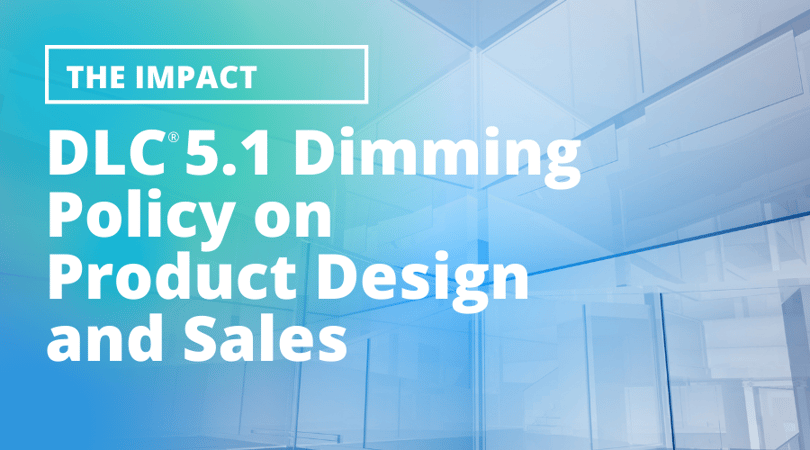Updated May 18, 2021 to reflect current DLC® requirements.
As of October 2020, due to changes in DLC® 5.1 Dimming requirements, 70-80% of DLC qualified lamps and tubes will be delisted in June 2022, and will therefore not be eligible for rebates in almost all C&I Utility Rebate programs in the US and Canada.
- April 15, 2022: Deadline to update V5.0 listed products to V5.1.
- June 30, 2022: Delisting date for V5.0 listed products that have not been updated.
Policy Change
At the beginning of 2020, the DLC finalized the requirements for its new 5.0/5.1 SSL program. In April 2020, Covid19 caused the DLC to make a few changes in the implementation, principally some changes in its calendar and also movement of all its dimming requirements changes completely to 5.1.
In 5.1, the dimming policy was changed to require dimming capability in nearly all products. The stated goal from the DLC around this requirement is “Virtually all listed products are dimmable, providing increased energy savings and more user satisfaction.” The only exceptions are for case/accent/flood lighting as well as some specialty/hazardous products.
This policy change has impacts on several stakeholders. Here, we are mostly focused on the manufacturers and their distribution chain. In a separate article, we will focus on energy savings impacts for utilities.
Product Design
From a product design perspective, there is a fair amount of work to do to maintain listing parity through the transition to 5.1. In the following table, we list the number of listed products that are currently registered as ‘Not Dimmable’ vs the total number of registered products by category as of October 2020.
Category |
Not Dimmable |
Total Product |
Percent Not Dimmable |
| Mogul (E39) Screw-Base Replacements for HID Lamps | 11,803 | 14,446 | 81.7% |
| Linear Replacement Lamp | 22,582 | 29,727 | 76% |
| Four Pin-Base Replacement Lamps for CFLs | 647 | 920 | 70.3% |
| Outdoor Retrofit Kit | 1,931 | 6,784 | 28.5% |
| Outdoor Luminaires | 62,773 | 246,843 | 25.4% |
| Indoor Retrofit Kit | 3,884 | 22,774 | 17.1% |
| Indoor Luminaires | 42,432 | 274,781 | 15.4% |
Obviously there is an unbalanced effect from this policy, where the great majority of lamps and tubes currently are not designed to be dimmable. From interviews with some manufacturers, there are technical and cost/design reasons for the current state of dimming in these products. Some examples of this feedback is:
- ‘A’ tubes that have to work on existing fluorescent ballasts
- HID replacement lamps are installed in industrial conditions that dimming is not permissible/desirable
Manufacturers are uncertain about how they will respond to this issue. Will they:
- Solve the technical issues that allow them to update products as dimmable
- Resolve to increase product pricing/absorb additional costs required to have dimming capabilities added
- Find more creative ways in which to claim their products are dimmable. There is no laboratory test for dimming, the policy is reliant on self-reported claims and product specification sheets for qualification
Program Response
Assuming the rate of delisting remains consistent through 2021-2022, what will the remainder of programs who incentivize tubes and lamps do in 2022? There are several paths we have already seen:
There are several utility programs that already incentivize non-DLC listed products. Several programs in Minnesota, Colorado, Ohio, South Carolina and even one program in California offer specific incentives at equal or a discounted rate. Will we see more of this?
When the 4.0 de-listing happened several years ago, we saw many programs implement their own individual delays in enforcement, up to 1 year. We could potentially see some programs continue to accept delisted tubes and lamps in a similar fashion.
Alternative QPLs. There have been other organizations and state programs who have offered alternative QPLs for certain product categories.
Sales Impact
Rebates for these products have certainly been influential to driving LED sales over older technology. What does the absence of rebates do to the sales of these products. Does it change stocking patterns to include more HID and fluorescent? Make the move to LED fixtures more economically compelling? We expect the answers to these questions to be more clear at the beginning of 2022, as we approach the deadline to update existing products to 5.1, and distributors are beginning their stocking plans for the end of 2022 and beyond.
.png?width=500&name=2019%20e%20news%20spotlight%20logo%20(1).png)





